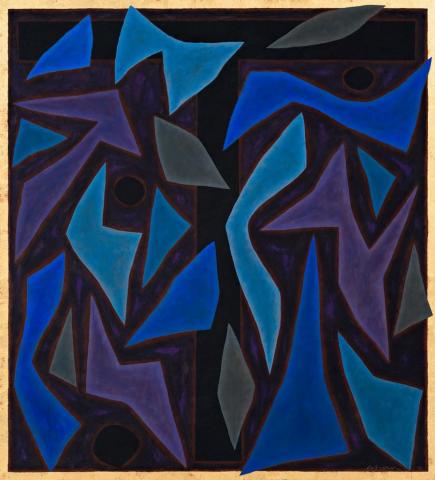LAMENTATION, 1986
John Coburn
oil on canvas
168.0 x 153.0 cm
signed and dated lower right: Coburn 86 inscribed and dated verso: JOHN COBURN / ‘LAMENTATION’ / (oil) / 1986
Art Galleries Schubert, Queensland (label attached verso)
Eva Breuer Art Dealer, Sydney (label attached verso)
Private collection, Sydney
Amadio, N., John Coburn: Paintings, Craftsman House, Sydney, 1988, p. 204
One of the striking features of John Coburn's art is the richness of its colours. Highly evocative in the creation of mood and feeling, his colours signal lamentation or joy, conjure up day or night, the seasons of the year, of the tropical north and the dry inland. His colours are allied to his forms, which in turn relate directly to the ideas and emotions expressed. In Lamentation, mood is created not only by the deep blues and reverberating outlines, but also by the sharpness and angularity of the forms. This anguish, expressed through colour and form, is given added power through a sense of visual pulsation.
As one of Australia's greatest religious artists, Coburn was familiar with the expression of elation and despair. In earlier paintings, his forms are more figuratively inclined, as in Crucifixion, 1959, in which the figure of Christ is surrounded by the sharply pointed shapes derived from thorns, and set against a passionate background of red. By contrast, Litany, 1958, (Art Gallery of New South Wales) calls upon blues and greens and uplifting geometric forms to suggest 'the feeling of prayer, sacred petitions, a formality of responses, chanted music and a ceremony of the Church.'1 In his first Blake Prize-winning painting, The Passion, 1960, (Catholic Institute of Sydney), Coburn combined blues and reds with shapes of sharpest pain to express in each part of the triptych The Scourging, The Crucifixion and The Crowning with Thorns. The colour blue has a range of metaphorical associations, not least being that of melancholy. Moreover, some of the world's greatest art has been devoted to lamentation, especially in poetry and the music of Bach, Mozart's Requiem, Tchaikovsky's Pathetique and others. In Coburn's Lamentation a rich glow emanates from the colours reflecting on that strange paradox of joy derived from sorrow. Of his art, Coburn said, 'Appearances are distracting. What you feel about a thing is important, not what it looks like. I don't want to teach people to see. I want to get them to feel.'2
1. Amadio, N., John Coburn Paintings, Craftsman House, Sydney, 1988, p. 28
2. Quoted in Klepac, L., John Coburn: The Spirit of Colour, The Beagle Press, Sydney, 2003, p. 33
DAVID THOMAS
